 W
WThe Siege of Angers was a siege of the French town of Angers on 3 December 1793 in the War in the Vendée.
 W
WThe Siege of Bellegarde commenced on 23 May 1793 and ended on 24 June 1793 when Colonel Boisbrulé's French garrison surrendered the Fort de Bellegarde to a Spanish army under the command of Antonio Ricardos. The capture of the fort gave Spain control of an important road through the Pyrenees. The siege took place during the War of the Pyrenees, part of the French Revolutionary Wars. Fort de Bellegarde is on a height overlooking the border town of Le Perthus, which lies on the modern A9 autoroute and Autovía A-7.
 W
WThe Childers Incident of 2 January 1793 marked the opening shots between British and French forces during the French Revolutionary Wars, the first phase of a 23-year-long war between the two countries. Following the French Revolution of 1789, diplomatic relations between the Kingdom of Great Britain and the French Republic had steadily deteriorated and France was in political and social turmoil. One of the strongest hotbeds of republican activity was the principal Atlantic naval base of the French Navy at Brest in Brittany, the scene of a significant mutiny in 1790.
 W
WThe Second Battle of Cholet was fought on 17 October 1793 during the French Revolutionary Wars, between French Republican forces under General Jean Léchelle and French Royalist Forces under Maurice d'Elbée. The battle was fought in the town of Cholet in the Maine-et-Loire department of France, and resulted in a Republican victory. D’Elbée was wounded and captured; he was later executed by Republican troops in Noirmoutier. The Royalist insurgent, Charles Melchior Artus de Bonchamps, was fatally wounded in the battle.
 W
WThe Battle of Collioure saw troops from the Kingdom of Spain attack a Republican French division during the War of the Pyrenees. The Spanish troops led by Gregorio García de la Cuesta were completely successful in ousting the French under Louis Pierre François Delattre from Collioure, Fort Saint-Elme and Port-Vendres. The contending sides were the Spanish Army of Catalonia commanded by Antonio Ricardos and the French Army of the Eastern Pyrenees led by François Amédée Doppet and Eustache Charles d'Aoust. In September 1793, the French successfully defended Perpignan from Spanish attack but December saw a series of French defeats. One of the French representatives on mission, Claude Dominique Côme Fabre was killed during the fighting at Collioure. Aoust and Delattre were arrested, condemned and executed by guillotine for the disaster.
 W
WThe Siege of Condé saw a force made up of Habsburg Austrians and French Royalists commanded by Duke Ferdinand Frederick Augustus of Württemberg lay siege to a Republican French garrison led by Jean Nestor de Chancel. After a blockade lasting about three months the French surrendered the fortress. The operation took place during the War of the First Coalition, part of a larger conflict known as the French Revolutionary Wars. Condé-sur-l'Escaut, France is located near the Belgium border about 14 kilometres (9 mi) northeast of Valenciennes.
 W
WThe Constitution of 1793, also known as the Constitution of the Year I or the Montagnard Constitution, was the second constitution ratified for use during the French Revolution under the First Republic. Designed by the Montagnards, principally Maximilien Robespierre and Louis Saint-Just, it was intended to replace the constitutional monarchy of 1791 and the Girondin constitutional project. With sweeping plans for democratization and wealth redistribution, the new document promised a significant departure from the relatively moderate goals of the Revolution in previous years.
 W
WThe Battle of Entrames was fought on 27 October 1793 during the French Revolutionary Wars. It pitted Republican forces against Vendée Royalists near Entrames in Mayenne, and it resulted in a Royalist victory.
 W
WThe Battle of Epierre was part of a larger War of the First Coalition campaign that pitted a Republican French army led by François Christophe de Kellermann against a numerically stronger Kingdom of Sardinia-Piedmont army commanded by the Prince Maurizio, Duke of Montferrat. Under the overall leadership of the Austrian commander in chief Joseph Nikolaus De Vins, Montferrat launched an offensive in mid-August 1793 to recapture the Duchy of Savoy from the French. Because the French were preoccupied with the Siege of Lyon, the Piedmontese recovered most of the Maurienne and Tarentaise Valleys, but they were stopped just short of Albertville and the reconquest of Savoy. In September, Kellermann launched a counteroffensive in which he adroitly switched his troops between valleys in order to drive back the Piedmontese. At Épierre, the French under Jean-Denis Le Doyen defeated the Marquis of Cordon in a local action. By 8 October the Piedmontese abandoned all their gains and withdrew to the crests of the Graian Alps. In spite of his victory, the suspicious politicians in Paris put Kellermann in arrest and he was imprisoned until November 1794.
 W
WThe Battle of Famars was fought on 23 May 1793 during the Flanders Campaign of the War of the First Coalition. An Allied Austrian, Hanoverian, and British army under Prince Josias of Saxe-Coburg-Saalfeld defeated the French Army of the North led by François Joseph Drouot de Lamarche. The action occurred near the village of Famars in northern France, five km south of Valenciennes.
 W
WThe Machecoul massacre is one of the first events of the War in the Vendée, a revolt against mass conscription and the civil constitution of the clergy. The first massacre took place on 11 March 1793, in the provincial city of Machecoul, in the district of the lower Loire. The city was a thriving center of grain trade; most of the victims were administrators, merchants and citizens of the city.
 W
WThe Battles of Fontenay-le-Comte were fought on 16 May 1793 and on 25 May 1793 during the French Revolutionary Wars, between forces of the French Republic under Alexis Chalbos and Royalist forces under Marquis de Lescure and Charles de Bonchamps. The battle was fought near the town of Fontenay-le-Comte in Vendée, France, and ended in a Royalist victory. The first battle resulted in the town's successful resistance to the insurgent army; the second battle resulted in the Vendean victory.
 W
WThe Battle of Hondschoote took place during the Flanders Campaign of the Campaign of 1793 in the French Revolutionary Wars. It was fought during operations surrounding the Siege of Dunkirk between 6 and 8 September 1793 at Hondschoote, Nord, France, and resulted in a French victory under General Jean Nicolas Houchard and General Jean-Baptiste Jourdan against the command of Marshal Freytag, part of the Anglo-Hanoverian corps of the Duke of York.
 W
WThe Siege of Le Quesnoy saw a force made up of Habsburg Austrians and French Royalists led by François Sébastien Charles Joseph de Croix, Count of Clerfayt lay siege to a Republican French garrison commanded by François Goullus. After two and a half week siege, the French capitulated after suffering heavy losses. The War of the First Coalition operation was fought at Le Quesnoy, located near the border with Belgium about 27 kilometres (17 mi) west of Maubeuge.
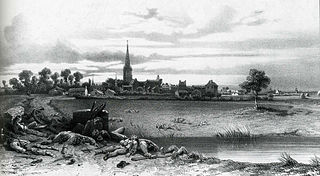 W
WThe final Battle of Luçon was fought on 14 August 1793 during the French Revolutionary Wars, between forces of the French Republic under Augustin Tuncq and Royalist forces under Maurice d'Elbée. The engagement on 14 August, fought near the town of Luçon in Vendée, France, was actually the conclusion of three engagements between the Vendean insurgents and the Republican French. On 15 July, Claude Sandoz and a garrison of 800 had repulsed 5,000 insurgents led by d'Elbee; on 28 July, Augustin Tuncq drove off a second attempt; two weeks later, Tunq and his 5,000 men routed 30,000 insurgents under the personal command of Francois-Athanese Charette.
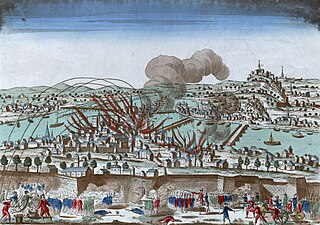 W
WThe Siege of Lyon occurred on 9 August to 9 October 1793 when French Republican forces laid siege and captured the city of Lyon, which was the centre of a revolt against the French government during the War of the First Coalition.
 W
WThe Siege of Maastricht was a failed siege of the city of Maastricht by the forces of the French First Republic from 6 February to 2 March 1793, marking the final action of the 1793 campaign of the War of the First Coalition. The city was successfully defended by the Dutch garrison with the assistance of a small band of French Royalists.
 W
WIn the Siege of Mainz, from 14 April to 23 July 1793, a coalition of Prussia, Austria, and other German states led by the Holy Roman Empire besieged and captured Mainz from revolutionary French forces. The allies, especially the Prussians, first tried negotiations, but this failed, and the bombardment of the city began on the night of 17 June.
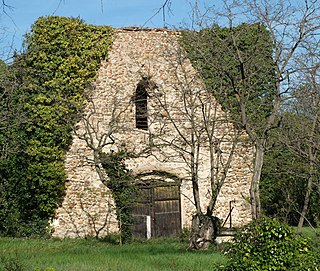 W
WThe Battle of Mas Deu or Battle of Mas d'Eu on 19 May 1793 saw the French Revolutionary Army of the Eastern Pyrenees under Louis-Charles de Flers fighting Bourbon Spain's army of Catalonia led by Antonio Ricardos.
 W
WThe Battle of Wervik, or of Wervik and Menin was fought on 12 and 13 September 1793 between 30,000 men of the French Army of the North commanded by Jean Nicolas Houchard, and 13,000 Coalition troops: the veldleger of the Dutch States Army, commanded by the William, Hereditary Prince of Orange and his brother Prince Frederick of Orange-Nassau, and a few squadrons of Austrian cavalry under Pál Kray, seconded by Johann Peter Beaulieu. The great superiority in numbers being on the French side the battle ended in a victory for France, with the Dutch army suffering heavy losses. Among the casualties was Prince Frederick, who was wounded in the shoulder at Wervik, an injury from which he never fully recovered. The combat occurred during the Flanders Campaign of the War of the First Coalition. Menen is a city in Belgium located on the French border about 100 kilometres (62 mi) west of Brussels.
 W
WThe First Battle of Noirmoutier took place on 12 October 1793 as part of the war in the Vendée. The Vendéens under François de Charette were victorious over the republican troops stationed there.
 W
WThe Battle of Perpignan or Battle of Niel (fr:Bataille de Perpignan) on 17 July 1793 saw the French Army of the Eastern Pyrenees led by Louis-Charles de Flers defending against an offensive by the Spanish Army of Catalonia commanded by Antonio Ricardos. The French turned back the Spanish attacks and forced their opponents to pull back. Perpignan is now the capital of Pyrénées Orientales department, but in 1793 was the chief city of Rousillon province. The action was fought during the War of the Pyrenees, part of the War of the First Coalition.
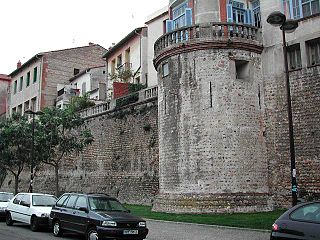 W
WThe Battle of Peyrestortes saw soldiers of the First French Republic fighting troops of the Kingdom of Spain during the War of the Pyrenees. Forces from the French Army of the Eastern Pyrenees, temporarily commanded by Eustache Charles d'Aoust and Jacques Gilles Henri Goguet, defeated two divisions of the Army of Catalonia led by Juan de Courten and Jerónimo Girón-Moctezuma, Marquis de las Amarillas. This Spanish setback in an attempt to capture Perpignan marked the high point of their invasion of Roussillon.
 W
WThe Battle of Pont-Barré saw Royalist Vendeans under Pierre Duhoux and Dominique Piron de La Varenne fighting a Republican French column under Charles François Duhoux near Saint-Lambert-du-Lattay. Duhoux's Republican column advanced southwest from Angers and encountered Vendean defenders led by his nephew Pierre at the bridge over the Layon River. The rebels held their ground until reinforcements under Piron La Varenne arrived and gained the upper hand. The Vendeans put the Republicans to flight, killing 1,362 soldiers and capturing all their artillery. The action was part of a Republican strategy of invading the Vendée from several different directions. The rebels concentrated against and defeated the encroaching columns one by one at Coron, Tiffauges, Pont-Barré, Montaigu and Saint-Fulgent.
 W
WThe Battle of Saint-Fulgent saw Royalist and Republican French forces clash at Saint-Fulgent during the War in the Vendée. The 11,000 Vendean rebels led by Henri de La Rochejaquelein defeated a 6,000-man Republican division commanded by Jean Quirin de Mieszkowski belonging to the Army of the Coasts of La Rochelle. Half of the Republican force was killed, wounded or captured while rebel losses were only one-tenth as high. In mid-September the Republican Army of the Coasts of La Rochelle led by Jean Antoine Rossignol advanced into the Vendée from the south and east while the Army of the Coasts of Brest and the Army of Mainz under Jean Baptiste Camille Canclaux advanced from the west. In a series of battles at Coron, Pont-Barré, Tiffauges, Montaigu and Saint-Fulgent, the Royalist rebels concentrated against and defeated each Republican column in turn.
 W
WThe First Battle of Saorgio saw a Republican French army commanded by Gaspard Jean-Baptiste Brunet attack the armies of the Kingdom of Sardinia-Piedmont and Habsburg Austria led by Joseph Nikolaus De Vins. The local Sardinian commander in the Maritime Alps was Charles-François Thaon, Count of Saint-André. Though the French were initially successful in this War of the First Coalition action, their main assaults against the strong defensive positions on the Massif de l'Authion and the Col de Raus failed with serious losses. Saorge is now located in France about 70 kilometres (43 mi) northeast of Nice, but in 1793 Saorgio belonged to Piedmont. In April 1794 the French seized the positions from the Austro-Sardinians in the Second Battle of Saorgio.
 W
WThe Battle of Thouars was a battle between Royalist and Republican French forces during the War in the Vendée. The Royalists or Vendeans led by Louis Marie de Lescure, Charles de Bonchamps and Henri de La Rochejaquelein seized the town of Thouars and compelled its Republican defenders under Pierre Quétineau to surrender.
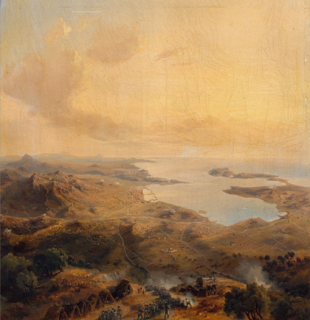 W
WThe Siege of Toulon was a military engagement that took place during the Federalist revolts of the French Revolutionary Wars. It was undertaken by Republican forces against Royalist rebels supported by Anglo-Spanish forces in the southern French city of Toulon. It was during this siege that young Napoleon Bonaparte first won fame and promotion when his plan, involving the capture of fortifications above the harbor, was credited with forcing the city to capitulate and the Anglo-Spanish fleet to withdraw. The British siege of 1793 marked the first involvement of the Royal Navy with the French Revolution.
 W
WThe Battle of Truillas was fought on 22 September 1793 during the French Revolutionary War between the French Army of the Eastern Pyrenees led by Luc Siméon Auguste Dagobert and the Spanish Army of Catalonia under Antonio Ricardos. This attempt by the French to exploit their success in the Battle of Peyrestortes ended in a Spanish victory. Part of the War of the Pyrenees, the battle was fought near the village of Trouillas in the French department of Pyrénées Orientales, 12 km southwest of Perpignan.
 W
WThe Siege of Valenciennes took place between 13 June and 28 July 1793, during the Flanders Campaign of the War of the First Coalition. The French garrison under Jean Henri Becays Ferrand was blockaded by part of the army of Prince Josias of Saxe-Coburg-Saalfeld, commanded by the Prince Frederick, Duke of York and Albany. Valenciennes fell on 28 July, resulting in an Allied victory.
 W
WThe Battle of Vihiers was a battle between Royalist and Republican French forces at Vihiers during the War in the Vendée. After the Republican division under Jacques-Marie Pilote La Barolière advanced into the heart of the revolt area, it was attacked by the Vendeans under Dominique Piron de La Vienne and routed. The advance guard under Jacques-François Menou held its ground for a long time, but many Republican units from the main body quickly took to their heels. The Republican cavalry under Louis-Nicolas Davout covered the disorderly retreat. The Royalists suffered about 1,000 killed and wounded but inflicted 2,000 killed and wounded on their enemies as well as capturing 3,000 soldiers and 25 artillery pieces.
 W
WThe Battle of Wattignies saw a Republican French army commanded by Jean-Baptiste Jourdan attack a Coalition army directed by Prince Josias of Saxe-Coburg-Saalfeld. After two days of combat Jourdan's troops compelled the Habsburg covering force led by François Sébastien Charles Joseph de Croix, Count of Clerfayt to withdraw. The War of the First Coalition victory allowed the French to raise the Siege of Maubeuge. At a time when failed generals were often executed or imprisoned, Jourdan had to endure interference from Lazare Carnot from the Committee of Public Safety. The village, renamed Wattignies-la-Victoire in honor of the important success, is located 9 kilometres (6 mi) southeast of Maubeuge.